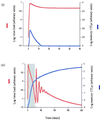Specific therapy regimes could lead to long-term immunological control of HIV
- PMID: 10588728
- PMCID: PMC24459
- DOI: 10.1073/pnas.96.25.14464
Specific therapy regimes could lead to long-term immunological control of HIV
Abstract
We use mathematical models to study the relationship between HIV and the immune system during the natural course of infection and in the context of different antiviral treatment regimes. The models suggest that an efficient cytotoxic T lymphocyte (CTL) memory response is required to control the virus. We define CTL memory as long-term persistence of CTL precursors in the absence of antigen. Infection and depletion of CD4(+) T helper cells interfere with CTL memory generation, resulting in persistent viral replication and disease progression. We find that antiviral drug therapy during primary infection can enable the development of CTL memory. In chronically infected patients, specific treatment schedules, either including deliberate drug holidays or antigenic boosts of the immune system, can lead to a re-establishment of CTL memory. Whether such treatment regimes would lead to long-term immunologic control deserves investigation under carefully controlled conditions.
Figures




Similar articles
-
Correlates of cytotoxic T-lymphocyte-mediated virus control: implications for immunosuppressive infections and their treatment.Philos Trans R Soc Lond B Biol Sci. 2000 Aug 29;355(1400):1059-70. doi: 10.1098/rstb.2000.0643. Philos Trans R Soc Lond B Biol Sci. 2000. PMID: 11186307 Free PMC article. Review.
-
The persistence of CTL memory.Neth J Med. 2002 Aug;60(7 Suppl):4-13; discussion 14-6. Neth J Med. 2002. PMID: 12430586 Review.
-
A new theory of cytotoxic T-lymphocyte memory: implications for HIV treatment.Philos Trans R Soc Lond B Biol Sci. 2000 Mar 29;355(1395):329-43. doi: 10.1098/rstb.2000.0570. Philos Trans R Soc Lond B Biol Sci. 2000. PMID: 10794051 Free PMC article. Review.
-
Helper-dependent vs. helper-independent CTL responses in HIV infection: implications for drug therapy and resistance.J Theor Biol. 2001 Dec 7;213(3):447-59. doi: 10.1006/jtbi.2001.2426. J Theor Biol. 2001. PMID: 11735291
-
The dual role of CD4 T helper cells in the infection dynamics of HIV and their importance for vaccination.J Theor Biol. 2002 Feb 21;214(4):633-46. doi: 10.1006/jtbi.2001.2483. J Theor Biol. 2002. PMID: 11851372
Cited by
-
Apoptosis in virus infection dynamics models.J Biol Dyn. 2014;8(1):20-41. doi: 10.1080/17513758.2014.895433. J Biol Dyn. 2014. PMID: 24963975 Free PMC article.
-
Genetic therapies against HIV.Nat Biotechnol. 2007 Dec;25(12):1444-54. doi: 10.1038/nbt1367. Nat Biotechnol. 2007. PMID: 18066041 Free PMC article. Review.
-
Boosting immunity by antiviral drug therapy: a simple relationship among timing, efficacy, and success.Proc Natl Acad Sci U S A. 2003 Feb 18;100(4):1855-60. doi: 10.1073/pnas.0337483100. Epub 2003 Feb 6. Proc Natl Acad Sci U S A. 2003. PMID: 12574516 Free PMC article.
-
Modeling T cell responses to antigenic challenge.J Pharmacokinet Pharmacodyn. 2014 Oct;41(5):415-29. doi: 10.1007/s10928-014-9387-8. Epub 2014 Oct 1. J Pharmacokinet Pharmacodyn. 2014. PMID: 25269610 Free PMC article. Review.
-
Modeling dynamics of acute HIV infection incorporating density-dependent cell death and multiplicity of infection.PLoS Comput Biol. 2024 Jun 7;20(6):e1012129. doi: 10.1371/journal.pcbi.1012129. eCollection 2024 Jun. PLoS Comput Biol. 2024. PMID: 38848426 Free PMC article.
References
-
- Larder B A, Darby G, Richman D D. Science. 1989;243:1731–1734. - PubMed
-
- Richman D D. Trends Microbiol. 1994;2:401–407. - PubMed
-
- Condra J H, Schleif W A, Blahy O M, Gabryelski L J, Graham D J, Quintero J C, Rhodes A, Robbins H L, Roth E, Shivaprakash M, et al. Nature (London) 1995;374:569–571. - PubMed
-
- Frost S D, McLean A R. AIDS. 1994;8:323–332. - PubMed
MeSH terms
LinkOut - more resources
Full Text Sources
Other Literature Sources
Medical
Molecular Biology Databases
Research Materials

